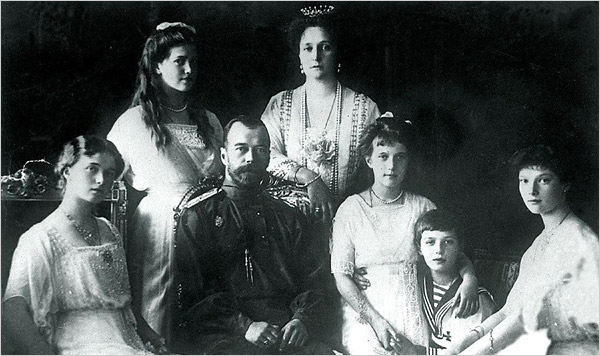But in a clear case of the angry revolutionaries being worse than the incompetent monarchy, the one thing Nicholas is most reviled for is not what he did but what he didn't do; making some easy, substantive changes that would have prevented the Bolsheviks from ever taking power and leading to the Soviet Union. His days were clearly numbered yet Nicholas II got a bit of a reprieve due to World War I, but near the end he had been deposed and replaced by a provisional government who were then attacked by the Bolsheviks. As forces neared the in-home prison of the royal family, future USSR leader Vladimir Lenin had them shot.
But out of that story, a legend rose which is really the only reason most outside Russia would even know of their story. Two of the children survived, the tale went, and might have been living in secrecy for decades. Anastasia, the perhaps missing princess, even got her story made into a Disney movie and Soviet leaders tracked down every claim they received.
But what truth to it? In 1991, the story came back into prominence because nine bodies, those of Romanov family members and servers, were found in a grave at Yekaterinberg, where the Bolsheviks had buried them in haste. That meant two were missing.

Czar Nicholas II and family. Credit: Agence France-Presse
New bone fragments were found in the summer of 2007, not far from the original discovery site about 900 miles east of Moscow, but they had been badly damaged by not only time and natural decomposition, but also by acid and fire, as the murderers apparently sought to fully destroy the bodies and evidence of the murder.
Russian officials asked a group of researchers to examine the new evidence.
The sad news for romantics; they completed basic studies of mitochondrial DNA inherited through the maternal lines and linked the remains genetically to Empress Alexandra, wife of the Czar, indicating that the remains were very likely those of the czar's children.
They were able to determine the complete mitochondrial genome sequences from the remains and then determined the gender of the bone fragments and recovered profiles of nuclear DNA, including that inherited exclusively through the paternal lines. The data conclusively demonstrated that the remains found belonged to children of the Romanovs, 13-year-old Crown Prince Alexei and one of his older sisters. This study, along with prior work, concluded that all five children—four daughters and one son along with their parents, last Russian Czar Nicholas II and his wife Empress Alexandra have been located and identified and thus none of the family members survived the 1918 murders.
They reconstructed the complete mitochondrial genome sequences from the remains and, analyzing specific Y-chromosome markers, were able to compare those with descendents of the paternal line. A critical link to the Romanovs was established via the DNA profiles from bloodstain specimens known to be from Czar Nicholas and held at the State Hermitage Museum in St. Petersburg, Russia - in 1891, Nicholas II was attacked in an apparent assassination attempt during a visit to Osaka, Japan. His bloodstained shirt was recently discovered in the museum.
"Children were murdered along with their parents, the Czar and Empress, and their attendants, in a basement of Ipatyev House in Yekaterinaburg in 1918. Their bodies were transported to a forest and were badly damaged in an attempt to eliminate evidence of this crime," said Evgeny I. Rogaev, PhD, professor of psychiatry at UMass Medical School's Brudnick Neuropsychiatric Research Institute and professor of genetics at the Russian Academic Institutions, who tried to use as little of the bone fragments as possible in order to preserve the remains for proper burial.
The murderers apparently attempted to destroy two of bodies and thus, they were not found in the first grave.
"The newly found bone fragments were fragile and difficult to work with, but we were able to extract enough uncontaminated genetic material to conduct the tests. Thus we were able to test the genetic connections through both maternal and paternal lineages.
"The bloodstain DNA profile for all DNA systems matched with that of the bone fragment DNA profiles, and so we could conclude the identity of the putative remains of Nicholas II with a great degree of confidence. The analysis of Y- chromosome markers demonstrated further the link between the bone fragment of putative Alexei to his father Tsar Nicholas II and the distant paternal relatives which must have inherited the same Y-chromosome markers from their common Imperial ancestor."
While DNA is present inside the nucleus of every cell of the body, mitochondrial DNA is distinct from nuclear DNA in that it possesses its own genome that exists outside of the cell nucleus. And whereas autosomal cchromosomal DNA undergoes the process of recombination, where sections of DNA from the mother and the father are mixed resulting in a more distorted genetic history, mitochondrial DNA, which is inherited only from the mother, or non-recombinant part of Y-chromosome DNA, inherited only from the father, allows for the tracing of a more direct genetic lines.
All of the Romanov children, including Crown Prince Alexei and his sisters, have the same type of mitochondrial DNA as their mother, Empress Alexandra, who was a granddaughter of Queen Victoria. Prince Philip of England is also a distant relative on his mother's side. Rogaev's team compared the mitochondrial DNA types extracted from the remains and also reviewed published information about the prince's DNA and, in addition, compared with mitochondrial DNA sequences from other distant maternal relatives of Queen Victoria in their work.
Article: "Genomic identification in historical case of Nicholas II Royal family" Rogaev at al, Proceedings of the National Academy of Sciences






Comments